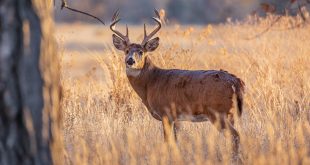Chronic Wasting Disease (CWD) remains prevalent across much of Colorado and continues to negatively impact deer, and to a much lesser extent, elk populations. To date, CWD has been detected in 40 of 54 deer herds, 16 of 43 elk herds and 2 of 9 moose herds. Colorado Parks & Wildlife (CPW) continues to study CWD and just released some interesting info on their CPW News Release site entitled: “CPW presents results of mandatory testing for chronic wasting disease at May Commission Meeting in Sterling” (small town in NE CO).

Map of CWD infection rates in harvested adult male deer in Colorado, 2017-2021.
(This CWD deer map, and the elk map below, are also in the 2022 Colorado Big Game brochure.)
At the May CPW Commission meeting in Sterling, CPW Terrestrial Programs Supervisor Matt Eckert provided an update to the Commission on the agency’s CWD mandatory testing efforts. From 2017-2020, CPW focused mandatory testing on deer because deer have the highest disease infection rates and greatest need for disease management. During this time, CPW examined CWD levels across all 54 deer herds. A variety of management methods have been utilized around the state since mandatory testing began. When infection rates are greater than 5%, wildlife managers have utilized tactics such as:
- Reducing population or density
- Reducing male/female ratio (males tend to have double the infection rates of females)
- Changing the age structure (4- to 6-year-old bucks tend to have the highest infection rates)
“Overall, the decision to commit to annual mandatory testing has been resoundingly important to understanding the status of this disease in Colorado,” Eckert said. “It’s helped us in acquiring and communicating reliable infection rate estimates and laying a foundation to assess herd-specific management actions to combat CWD.”
According to the 2022 Colorado Big Game brochure, Deer section, page 20, MANDATORY CHRONIC WASTING DISEASE (CWD) TESTING IN SELECT GMUs: In 2022, CPW will require mandatory submission of CWD test samples (heads) from all deer harvested during rifle seasons from specific hunt codes, at no charge. Not all hunt codes in a unit were selected for mandatory CWD testing. Hunt codes selected for mandatory deer testing are (highlighted in green in the brochure). Speaking for myself, I’ve had my deer tested several times and CPW does a great job of making the process quick and easy.
2021 Mandatory Elk CWD Testing Summary
CPW focused on elk in 2021, which provided the first reliable infection rate estimates for elk since the mid-2000s.

Map of CWD infection rates in harvested adult and yearling elk in Colorado, 2017-2021.
In 2021, CPW tested its 14 highest priority elk herds, with special emphasis on those that overlap high-prevalence mule deer herds. Eckert said the testing helped CPW learn that:
- CWD in elk is still relatively low in elk herds statewide.
- Detection of infected yearling elk is higher than expected.
- Geographic patterns of high infection level areas generally overlap for elk and deer.
“Not only were we interested in generating reliable estimates of CWD infection rates in elk, but we also wanted to analyze relationships of CWD infection rates among mule deer and elk harvested in the same areas,” Eckert said. “If management actions prescribed in our most infected deer herds successfully maintain or reduce CWD, those same actions taken for deer may also affect CWD infection rates in elk over time.”
Read the complete CWD update to the Commission here.
What is CPW doing to address CWD?
CPW is working to ensure the long-term health of deer, elk, and moose herds. Over time, this means minimizing the number of animals that get infected and die from this disease. To date, management actions have been prescribed for 27 deer herds designed to reduce infection levels to below the 5% threshold. More information about the plan to manage CWD is available in the Colorado Chronic Wasting Disease Response Plan.
From my perspective, to combat the spread of CWD in our deer population, CPW is attempting to reduce the number of older bucks that are more likely to be carriers. While CPW is doing its best, I can tell you some hunters view these steps negatively because the result can be a significant reduction in mature bucks available to hunt. One management method of doing this (not specifically discussed in this study) is CPW’s current five-year plan which moved hunting season well into November, often during the rut, giving hunters a big advantage. This is designed to put more mature bucks on the ground. Last year was the second year under the five-year plan, but it didn’t quite work out. In many GMUs, like the one I hunted 4th season, the weather was very mild with no snow at all, and the rut had not yet kicked in. So, for the most part, the big bucks stayed hidden and there wasn’t a significant increase in total numbers harvested. We’ll have to wait and see how it turns out next season.
What are the health risks to humans?
CWD is a prion disease that affects Colorado’s deer, elk, and moose. The disease course generally lasts 2-3 years in deer and is always fatal. Although there has been no evidence that CWD has transmitted to a human, the Center for Disease Control, CPW and the Colorado Department of Public Health & Environment all recommend that hunters not eat the meat of a CWD-infected animal.
According to the 2022 Colorado Big Game brochure, page 13:
IMPORTANT PUBLIC HEALTH MESSAGE Disease in humans resulting from CWD exposure has not been reported to date. However, public health officials cannot determine there is no risk from eating meat from infected animals. Consequently, officials recommend that people avoid exposure to CWD-infected animals. To minimize exposure to CWD and other diseases of potential concern, CPW advises hunters not to shoot, handle or consume any deer, elk or moose that is acting abnormally or appears to be sick. When field-dressing game, wear rubber gloves and minimize the use of a bone saw to cut through the brain or spinal cord (backbone). Minimize contact with brain or spinal cord tissues, eyes, spleen, or lymph nodes. Always wash hands and utensils thoroughly after dressing and processing game meat.
Source: https://cpw.state.co.us/aboutus/Pages/News-Release-Details.aspx?NewsID=8168
 Eastmans' Official Blog | Mule Deer, Antelope, Elk Hunting and Bowhunting Magazine | Eastmans' Hunting Journals
Eastmans' Official Blog | Mule Deer, Antelope, Elk Hunting and Bowhunting Magazine | Eastmans' Hunting Journals




